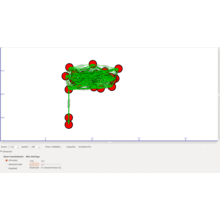Tag Archive: '2016 ns3 projects'
There has been a significant increase in recent years in the volume and diversity of streams of data, data streams from sensors, data streams arising from the analysis of content or data mining, right through to user generated Twitter streams. There has been a corresponding increase in demand for more real-time analysis of these streams in […]
Self-organizing dense sensor networks are expected to resolve the challenges of spectral efficiency, energy efficiency, and device management. This paper explores the use of information dependence among sensors to form a community structure of sensor data, and uses this structure to develop an information- centric processing methodology to achieve self-organizing dense sensor networks. Moreover, a data aggregator adopts ℓ1 regularization to easily enhance energy efficiency […]
Increasing population density, closer social contact and interactions make epidemic control difficult. Traditional offline epidemic control methods (e.g., using medical survey or medical records) or model-based approach are not effective due to its inability to gather health data and social contact information simultaneously or impractical statistical assumption about the dynamics of social contact networks, respectively. In addition, it is challenging to find […]
In this paper, we extend our previous work on content retrieval in Disruption Tolerant Networks (DTNs) to support cooperative caching. Our caching scheme can adapt to the unstable network topology in DTNs, and enable the sharing and coordination of cached data among multiple nodes to reduce data access latency. Our key idea is to cache data at cluster head […]
We introduce a new tendency measure for a probability mass function (pmf) referred to as “tenor,” and defined in terms of the phase of the first non-zero frequency of the discrete Fourier transform of the pmf. This statistic is in the vicinity of the region of highest probability of the pmf. Unlike mean, tenor is […]
The paper presents the results of simulation verification of trust-based protection mechanism (TUBE) to attacks on a reputation systems. The authors give a short description of TUBE scheme and present a review of typical reputation attacks. The TUBE scheme supports the MANET nodes operations allowing assessment of the nodes surrounding and use of this information to increase […]
Development of intelligent transportation system is the need of all the developing countries where urbanization and industrialization is rapidly growing. VANETs are being used as a tool for improving road safety by alarming the drivers about accidents occurred ahead of them or for providing internet access to the passengers via gateways along the road. Due […]
In mobile ad-hoc networks (MANETs), there are selfish nodes, which drop the received data packets, because nodes have limits of their resources. Secure routing protocols are developed as one of security mechanisms. In secure routing, each node can detect selfish nodes and decide secure paths by consulting trust values. Here, trust values express reliability for […]
A broadcast operation is the fundamental transmission technique in mobile ad-hoc networks (MANETs). Because a broadcast operation can cause a broadcast storm, only selected forwarding nodes have the right to rebroadcast a broadcast message among the one-hop and two-hop neighboring nodes of a sender. This paper proposes a novel algorithm to minimize broadcasting redundancy in […]
This paper reports experimental results on self-organizing wireless networks carried by small flying robots. Flying ad hoc networks (FANETs) composed of small unmanned aerial vehicles (UAVs) are flexible, inexpensive and fast to deploy. This makes them a very attractive technology for many civilian and military applications. Due to the high mobility of the nodes, maintaining […]

 Click Here to watch our latest output video using NS3 simulator
Click Here to watch our latest output video using NS3 simulator  Click Here to watch our latest projects screenshots using NS3 simulator
Click Here to watch our latest projects screenshots using NS3 simulator